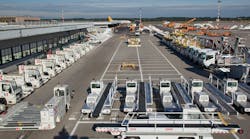Denver International Airport (DEN) is one of the busiest airports in the world. It’s also one of the best, by nearly any measure. It has been rated as the best airport in North America that serves 50 million or more passengers per year, and that praise is not simply because of the spectacular views of the Rocky Mountains that constantly remind you that you’re in a very special place. Passengers and industry experts alike give DEN enviable ratings on an annual basis for how well designed the airport is, how efficiently it is operated, the quality of the amenities and even how clean the restrooms are. The great views are just a bonus.
If you live in Denver like we do, it’s commonplace to hear people say, “I’m heading out to the airport a bit early to relax before I head out,” or hear out-of-town friends say, “I had a layover in Denver and it was lovely. Wish this were my local airport.” That passenger experience isn’t an accident. We know that firsthand from working with the team at DEN, who carefully cultivate that experience to make the airport a true oasis for passengers. People may think that their getaway starts when they arrive at their destination, but airports like DEN are changing that deeply-ingrained perception by making passengers feel like they have departed as soon as they arrive at the facility. It starts with the airport’s iconic architecture and commitment to investing in art installations, which immediately make passengers feel transported. But it doesn’t stop there, and that’s where a recently-launched visual wayfinding system at the airport comes in.
One of the thing that is always mentioned about DEN in the high ratings given by passengers and travel journalists is the quality of the dining, shopping and other services at the airport. Not only is the quality remarkable, but it’s a true reflection of what makes Denver special:
- You can get the same incredible steaks at DEN that you can at Denver institutions like Elway’s and the Denver Chop House
- You can taste Colorado’s best microbrews at the Boulder Beer Tap House just like you’re going for a stroll in Boulder
- You can get a cup of some of Denver’s best coffee at Dazbog Coffee at the airport just like you can at their charming cafes in town
- There’s a taste of the mountains if you get a gift box of elk or buffalo jerky from Climax Jerky
- Heidi’s Brooklyn Deli is there — another Denver institution
- So is one of Colorado’s nationally beloved craft brewer’s New Belgium
- And so it Tattered Cover, which is one of the world’s great bookstores
- Plus so many other places to dine, shop and relax
The bottom line is that there is a lot to do at DEN, by design. The airport has done a great job of making this a showcase for the state of Colorado. In many ways, it’s the best of Colorado all in one place. And these carefully curated concessions are an important source of revenue for the airport in a time when non-aeronautical revenue is critical to every airport around the world. As every reader of Airport Business magazine knows, aeronautical revenue is highly volatile even for an airport as consistently busy as DEN, which is one of the top 20 busiest aviation facilities in the world. Growing concessions-related revenue is one of the most important ways that airports can even out the volatility of aviation revenue and maintain a solid financial foundation for the airport, and DEN’s implementation of a new visual wayfinding solution created by our team at Four Winds Interactive is proving that this visual communications technology is a valuable tool for achieving that goal.
DEN is unique in its design with a terminal featuring the Great Hall under the iconic white-tented rooftop that echoes the peaks of the Rocky Mountains. Automated trains connect the terminal to three concourses (A, B and C) with 107 gates and 42 apron loading positions. That layout means that the airport’s vast concessions operations stretch from a large collection of restaurants and shops in the pre-security area of the Great Hall to a variety of retail areas in each of the three concourses. DEN wanted to encourage arriving passengers and layover travelers to fully understand the wealth of dine/shop/relax options at the airport and find things quickly while also getting wayfinding information for departing gates at the same time.
DEN worked with Denver-based marketing company Street Source Marketing and Communications to issue an RFP for a visual wayfinding solution that would replace static signage with a digital solution that:
- Promotes the variety of concessions options available at the airport in a dynamic way
- Provides effective wayfinding to passengers to make their way to the dine/shop/relax location
- And also provides other valuable information such as flight status and wayfinding to their gate
Our team at Four Winds participated in the RFP and worked with Street Source and DEN to implement a successful pilot project before expanding to additional locations in the airport. The wayfinding systems are embedded in attractive physical kiosks built by Boyd Sign Systems featuring 55-inch touch sensitive interactive screens by NEC Display. The current scope of the implementation includes 16 wayfinding kiosks at strategic locations throughout the airport that were determined through a quantitative assessment during the pilot program to determine the most effective sites. Wayfinding screens are located in the pre-security area of the main terminal, at each of the train landings where the automated trains drop off and pick up passengers on the way to concourses, and in each of the wings of the concourses themselves.
What our team at Four Winds has found in our implementations at dozens of airports around the world is that there is a resistance among passengers to downloading special apps to assist with wayfinding at airports. That resistance is cross-generational and crosses demographics. What passengers feel more comfortable using are large-format kiosks with interactive information to select the information they want, with the option to take select information with them that doesn’t require an app download.
The touchscreens are designed to attract users with attract loops that show images of the kinds of foods and services that are available from DEN concessionaires. For example, who can resist a picture of ice cream cones with sprinkles?
Once a passenger is at the interactive screen, they can get a variety of information about their flight through an interface that is linked directly to the airport’s FIDS and other information systems. They can either scan their boarding pass or type in information on the touchscreen, which then pulls up the current status of their flight and latest gate information.
That information is available from many sources both in the airport and on their mobile phone, but one thing that makes these screens so useful to passengers is that they provide highly intuitive wayfinding in a variety of formats. It can display it in a map on the screen. It can provide turn by turn instructions that can be texted or emailed to your phone.
The wayfinding system’s flight information and gate-related wayfinding is simply a bonus, though, because the centerpiece of the implementation is a platform that promotes concessionaires throughout the airport…and then helps passengers get there efficiently. When passengers come to the screen, the first three icons they see on the main screen are “Dine,” “Shop” and Relax”—matching the three categories of concessions available at DEN.
The screen walks passengers through a list of options, allowing them to tap for more information, including menus for the restaurants, a list of services for the spas, and more. Here’s an example for Elway’s steakhouse.
Once a passenger makes a selection, the wayfinding system gives them all of the wayfinding options mentioned above for finding gates, including a visual map on the screen and turn-by-turn directions that can be sent to your smartphone. The system even provides a photo of the storefront to give passengers a specific visual of what to look for when they approach the end of the directions.
One of the things that passengers particularly like is the way that concessions options are customized based on things like the amount of time until the flight departure. For example, if a passenger has more than 45 minutes until their flight departs, the screen will display the full range of dining options, including full-service restaurants. If there is less than 45 minutes until the departure, the system will automatically refine the search results to quick-service options.
The entire wayfinding system is controlled with a software system designed by Four Winds Interactive that gives DEN complete control over content and allowing concessionaires to communicate customized messages based on any number of factors: time of day, location of the kiosk in the airport, day of the week, special events that are bringing travelers to Denver, and much more. Four Winds also integrated the wayfinding system with the same data source that is used to concessions and amenities information on DEN’s website, allowing updates to automatically be made to multiple systems from the same source the airport is already using. These types of visual communications systems are only as effective as the software that powers them, which must give an organization the ability to customize content in a way that is simple and effective.
One interesting aspect of this project that we should mention is how we worked with DEN to customize how the system is integrated with their emergency communications processes. These screens can be used to deliver emergency messages that are controlled by the airport, for example directions to exit points. In the case of DEN, we designed the system to align with the airport’s strategy of reducing visual and audio stimuli during an emergency so that passengers can focus on the information being given by airport employees on the floor or over loudspeakers. To align with that strategy, our screens are designed to automatically fade to black in those scenarios.
Visual communications via interactive screens is one of the most powerful tools that airports have for capturing the attention of passengers and communicating effectively with them in an environment where they are moving so quickly and where there is so much other information and stimulus coming at them. DEN’s wayfinding implementation for passengers is proving how effective they can be for enhancing passenger experience and driving concessions revenue.
Chris Hill and Randal Dick lead the airport and transportation working group at Four Winds Interactive, which is a leader in the visual communications industry that works on high-visibility projects with airports and other organizations around the world. Chris Hill has more than 20 years of overall experience in the technology industry, with nearly eight years of that at Four Winds. He earned his degree from Colorado State University. Randal Dick has 32 years of experience in the software industry, including senior roles at JD Edwards and PeopleSoft. He has been with Four Winds for eight years, and he earned his degree at USC. Four Winds’ airport and transportation team has worked on prominent projects at airports across the globe, including Montreal international Airport, Boston Logan International Airport, Changi Airport Singapore, Las Vegas McCarran International Airport, Zurich Airport and dozens more.



